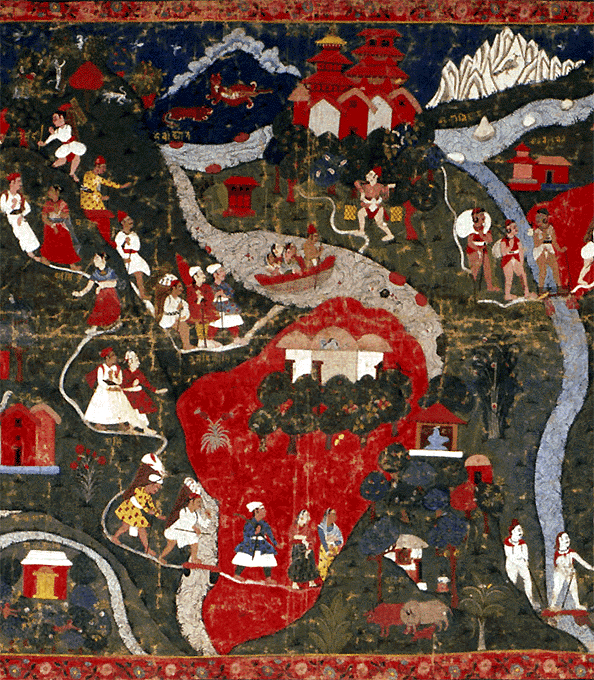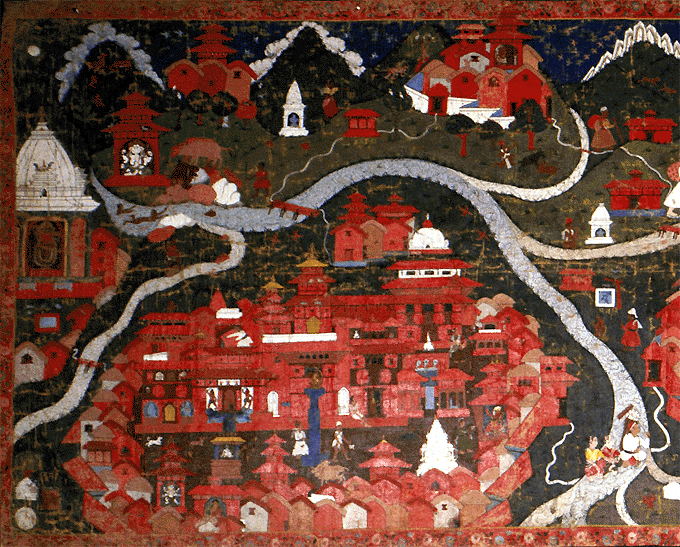Nepal in the Mahabharata Period, Part 36
BY: SUN STAFF - 10.12 2018

Nepal Pilgrimage From Kathmandu Valley to Gosainkund
Nepal, 17th-18th Century
© Philadelphia Museum of Art
The Yadava dynasty's presence in Nepal, and the events that preceded and followed.
After the very brief rule of the Soma kings in Nepal, a new dynastic era began, known as the Licchavi Period, from around 400 to 800 A.D. The Licchavis arrived in Nepal much like the Somas, attacking from Mithila (northern Bihar) India in the south. Some records say that the last Kirat king, Gasti, was attacked not only by Somas, but by the Licchavis as well. Either way, the start of the Licchavis rule is generally given as 400 A.D., after the demise of the last Soma king.
The Licchavi are thought to have been of Rajput ancestry. Various Sanskrit inscriptions place them in Nepal's ancient history. The period of their rule was something of a golden period for Nepal, as relationships with India, Tibet and China were strengthened. It was the Licchavi king Amsuvarma who gave his daughter, Bhirkuti, to marry the powerful king of Tibet, discussed in a previous segment. The Licchavi King Nemikh also traced his roots to a kshatriya lineage (or Vratya Kshetri) out of north India.

Nepal Pilgrimage From Kathmandu Valley to Gosainkund
Although the history of the Licchavi in Nepal is no doubt interesting, it is not relevant to this discussion, except to bring the timeline forward from the long period of Kirat rule to the reign of the Malla kingdom.
Just as the Soma king Bhaskerverma drove his forces south to plunder Rameswaram, and used that wealth to gold-plate the roof of Nepal's Pashupatinath temple, so did invaders from India again come north to attack Nepal. From the 13th to 18th Centuries (1200-1769 A.D.), the Malla dynasty ruled Nepal, bringing a strong Vedic influence to the country. A great deal of the finest art and architecture found in Kathmandu Valley was created during the period of Malla rule. In fact, the Malla dynasty marked a glorious era in the history of Nepal, improving society at all levels: art and architecture, religion, culture, commerce and politics. Under their rule, the citizens of the Kathmandu Valley began calling themselves 'Newars', or citizens of Nepal.

Nepal Pilgrimage From Kathmandu Valley to Gosainkund
Nepal, 17th-18th Century
© Philadelphia Museum of Art
The painting featured today, in full and in detail, is an exceptional representation of Malla Period art. Painted most likely in Bhaktapur in the late 17th to early 18th Century, the 14 foot long narrative depicts a Nepal Pilgrimage From Kathmandu Valley to Gosainkund. As described by AsianArt.com:
"Pilgrimages within Nepal and between Nepal and India predate written histories, and the Nepalese landscape is filled with shrines that mark sites sacred to both Hindus and Buddhists. This long, richly detailed painting shows pilgrims progressing toward the holy lake of Gosainkund, in which appears an image of a reclining god worshiped by Hindus as Shiva and revered by Buddhists as the compassionate bodhisattva Avalokiteshvara.
The Nepalese cities depicted along the route-including Patan, Kathmandu, and Baleju-are identifiable by their distinctive buildings and landmarks. For example, the white building next to the blue pillar in the city at lower left is the famous stone Krishna temple in the city of Patan. This structure was built by the Malla king of Patan (Siddhinarsingh Malla) in 1637, shortly after he made a pilgrimage to the holy city of Varanasi (Benares) in India, and was modeled on temples he saw there. Thus its presence helps to date this painting."

Nepal Pilgrimage From Kathmandu Valley to Gosainkund
Mention of the Malla can be found in the Mahabharata and in Buddhist literature. In Sanskrit, mallatranslates to 'wrestler' or 'boxer', indicating a person of great strength and power -- not unlike the famed Bhimasen. In fact, the Malla even claimed that their line came from a reincarnation of Lord Vishnu. The name 'Malla' was appended to the names of many Nepali kings, right up to the 18th Century, and is an indicator of Vaisnava rulership, rather than Buddhist of Shaivite.
Sri Mahabharata (II.30.3) states that the second Pandava, Bhima, is said to have conquered the chief of the Mallas during an expedition to eastern India. Mahabharata mentions the Mallas along with the Angas, Vangas, and Kalingas as eastern tribes. (VI.9.46) Like the Licchavis, the Mallas are mentioned in Manu-smriti as Vratya Kshatriyas. They are called Vasishthas (Vasetthas) in the Mahapparnibbana Suttanta. During the time of Gautama Buddha, the Mallas were frequently mentioned in Buddhist and Jain works.
The Malla era greatly shaped the religious landscape in Nepal. They introduced the dramatic chariot festivals of Indra Jatra and Matsyendranath, and in the mid-1600's, King Pratap Malla build many of Nepal's most famous Vaishnava temples and shrines, including the Krishna mandir. He constructed the Hanuman Dhoka palace in Kathmandu, and began the practice of building pillars like the famed Garuda-stambha, with a figure of the king perched atop, facing the protective temples of Taleju (Durga), who the Malla adopted as their protective deity.

Nepal Pilgrimage From Kathmandu Valley to Gosainkund
While the Malla were decidedly Vaisnava, they were very accepting of Buddhism and Shaivism, and that religious tolerance remains firmly fixed in Nepal culture. Along the lines of varnasrama-dharma, they divided society up into 64 occupational castes. King Jayasthiti Malla codified Nepal society law in dharmic terms, and this became the source of legal reforms through the 20th Century.
In our next segment, we'll look at some of the most important deity sculptures installed by the Vaisnava Malla rulers, including several of Nepal's most wonderful images of Lord Nrsimhadeva.






































